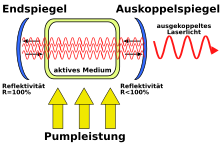Optical resonator
An optical resonator is an arrangement of mirrors that is used to reflect light as often as possible .
Types
If the optical path length of the resonator is a multiple of half the wavelength of the incident light, a standing wave forms due to interference in the resonator ; such arrangements are referred to as standing wave resonators . In addition, there are also arrangements in which there is no standing wave, e.g. B. ring resonators .
Depending on the geometry of the mirror structure, a distinction is made:
- unstable resonators, where a light beam can escape from the structure after a few reflections
- stable resonators in which a beam of light runs back into the resonator itself.
Possible arrangements are:
- planar resonators: both mirrors flat (mirror radii )
- concentric resonators: both mirrors spherical , radii each equal to half the resonator length ( )
- confocal resonators: both mirrors spherical and each in the focus of the other; Radii each equal to the resonator length ( )
- semiconfocal resonators (referred to as hemispherical in the figure ): one mirror flat and in the focus of the other, spherical mirror; d. H. The radius of the spherical mirror is equal to the length of the resonator.
calculation
The simplest and most important design is the Fabry-Pérot resonator , consisting of two parallel flat mirrors at a distance . The resonance condition for the formation of standing waves is then that a multiple of half the wavelength must fit between the mirrors.
The distance between two resonance frequencies is called the free spectral range (FSR, of Engl. Free spectral range ):
with the speed of light in the resonator.
The transmission of the resonator, i.e. the ratio of incident and exiting intensity , depends on the frequency and is described by the Airy formula . The transmission maxima are more sharply defined or their half-widths are smaller, the better the mirrors reflect, i.e. H. the higher their reflectivity is.
The half width of the maxima is
The factor that occurs is called finesse and is the key figure for resonators, which indicates the spectral resolution . If the losses in the resonator are neglected, the finesse only depends on the reflectivity of the mirrors (high reflectivity -> high finesse -> high spectral resolution or low half-width):
Depending on the mirrors used, the finesse can take on values from about 10 to several 100,000.
application
Laser resonators
An optical resonator is an essential part of almost every laser . On the one hand, it serves to determine the direction of the induced emission: photons emitted only along the resonator run back and forth several times in it and therefore primarily stimulate further emissions running in this direction. On the other hand, in the case of active media with little amplification, each photon must be better used by repeated passage in order to stimulate further emissions in order to meet the laser condition. The laser resonator is used - possibly in connection with other components - for frequency and mode selection.
The increased light intensity due to multiple reflections within the resonator compared to the decoupled laser beam facilitates the non-linear optics . One example is the frequency doubling in the resonator, the efficiency of which increases with the square of the field strength.
In the case of laser diodes , the outer surfaces of the semiconductor material themselves form the resonator in the simplest case, because a certain reflection always occurs here due to the greatly different refractive index of the semiconductor and its surroundings . Therefore no external mirrors are required. The optical path length of the resonator and thus the wavelength of the emitted light can in this case be controlled via the temperature or the current flowing through the material (influences the refractive index). However, there are also diode lasers that use an external resonator for wavelength selection, so-called ECDL ( external cavity diode laser ). Laser diodes with anti-reflective surfaces are often used in order to switch off the intrinsic resonator effect described above.
Spectroscopy and wavelength selection
Mechanically and thermally stabilized optical resonators are used as optical frequency references for spectroscopy and the frequency stabilization of lasers, and there is also the method of cavity ring-down spectroscopy .
In quantum optics or resonator quantum electrodynamics , the interaction of atoms with the light field in resonators with extremely high finesse is investigated.
Every optical resonator is also suitable for wavelength selection due to structural interference. The selection (contrast ratio) is higher, the higher the reflectivity of the mirror. Interference filters can be implemented by suitable arrangements of several reflective layers .
Modern absorption - spectrometer for the analysis of gases and liquids also operate with adjustable optical resonators by back calculate the variations of the intensity curve to the absorption of certain wavelengths.













